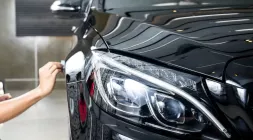How deep is your knowledge of car engine?
The main principle of car engine is igniting fuel in a small enclosed space resulting in a great amount of energy in the form of a gas.
Have you ever wonder what’s going on under the hood of your car? How does your car engine work? A car engine looks like a very complicated compilation of wires, metals, and tubes. Do you want to know more about the car’s engine?
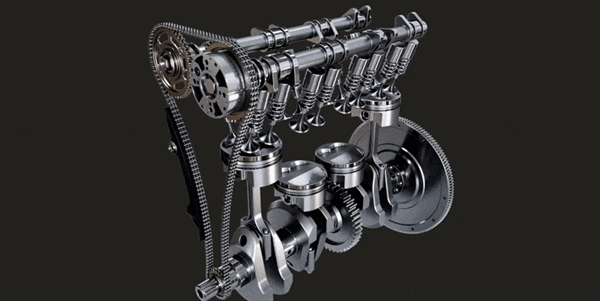
How does your car engine work
Perhaps you are planning to buy a new car, or already have one but don’t know anything about it except starting it. In this article from Philcarnews.com, we will tackle everything you need to know about a car engine. How does it work? What are the different parts of it?
What is an automotive engine?
A car engine is used to move your car by converting gasoline into motion. The easiest way there is to generate motion from gasoline is by burning the gasoline. It is burned inside the car engine thus it is called an international combustion engine. The combustion happens internally.
There are two types of internal combustion engines. It can be either a diesel engine or a gas turbine engine. Each of these two has its own disadvantages and advantages. On the other hand, there is another kind of engine known as an external combustion engine.
One example of this is the engine of old-fashioned trains. The fuel in the steam engine is burned outside to create steam. The steam will then produce motion in the engine.
>>> Related: What is a cambelt and when to replace the failing ones?
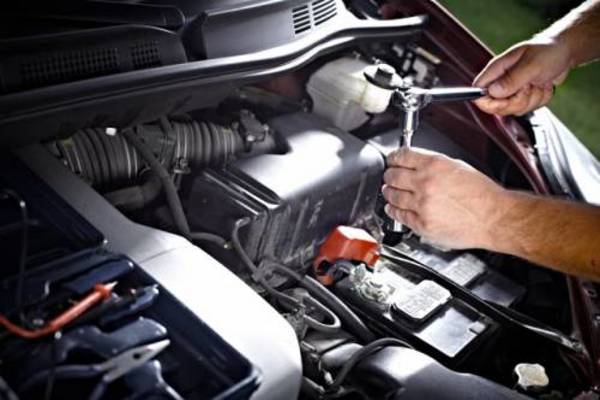
A car engine is used to move your car by converting gasoline into motion
How does a car engine work?
As discussed above, a car engine is an internal combustion engine. It is more efficient and a lot smaller than external combustion. The main principle of this engine is igniting fuel in a small enclosed space resulting in a great amount of energy in the form of a gas.
This gas is then utilized by the engine to propel the car. This principle is the same when a person is hungry. In the case of a person, you feed him food while in cars, you feed it with fuel.
The human body then converts the food into energy the same as the engine converts the fuel into energy. Some modern vehicles, known as hybrids, also make use of electricity from batteries for moving the car.

A car engine is an internal combustion engine
A usual car engine generates hundreds of explosions per minute. The engine binds the created energy and then uses it in propelling the vehicle. The explosions make the engine piston to move.
If the energy from the explosion has almost vanished, another explosion will occur. The piston is then forced to move again. The cycle goes on and on, providing the needed power for the car to run.
Almost all of the car engine is a four-stroke engine. It is the most usual type of an internal combustion engine that needs four-stroke to complete one cycle of piston.
These strokes are continuous, generating power for the car. For a more detailed version of these strokes, let us take a look at the following.
>>> Related: Everything You Need to Know About the ECU
Intake stroke
This is the first cycle of a four-stroke engine. During this cycle, air and fuel are drawn inside the cylinder. The air passes through the inlet valve which in this cycle is opened.
The fuel injector injects the fuel inside the cylinder to attain the air-fuel ratio. The movement of the piston going down causes the fuel and air to be drawn into the cylinder.
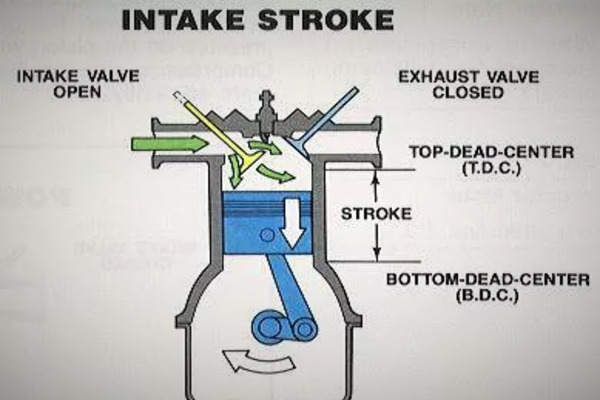
Intake stroke is the first cycle of a four-stroke engine
Compression stroke
The next cycle is The piston moves upward pushing the air and fuel mixture compressing it towards a smaller space. The compression helps the fuel-air mixture to become volatile for easy ignition.

In the compression cycle, both the exhaust and intake valves are closed
Combustion stroke
In this stroke, the valves are still in the closed position. Spark is produced through the spark plug to ignite the mixture of air and fuel that has been compressed. The resulting energy or power from the combustion pushes the piston to go down.
>>> Related: 7 common car maintenance myths you might wonder one day
Exhaust stroke
This is the last cycle in the four-stroke engine. The exhaust valve will open to release exhaust gas created during the explosion. The gases are forced by the upward movement of the returning piston.
These gases pass to a converter first to be cleaned, before it departs the vehicle over the tailpipe. This cycle goes on and on until you stop the car’s engine.
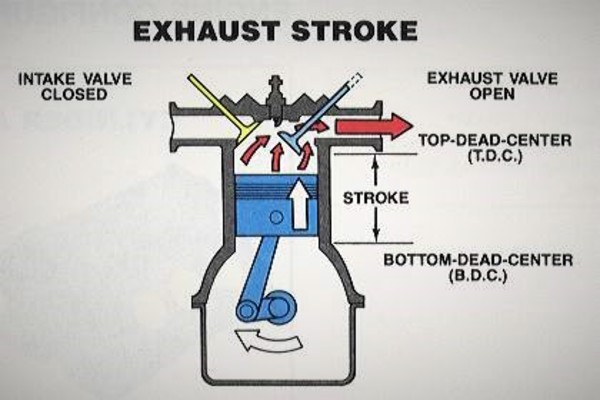
Exhaust stroke is the last cycle in the four-stroke engine
What are the parts of a car engine?
The following are some of the main parts of a car engine.
Cylinder
This is the core of a car’s engine. This is the space wherein the piston moves either up or down.
Spark plug
The spark plug provides the spark in the cylinder causing the mixture of air and fuel to ignite. With this, the combustion cycle can take place. The spark should be supplied at the right time for things to happen properly.
Valves
There are two valves in the car’s engine; inlet and exhaust valves. These valves should open at the right time to let the air and fuel in and also let the exhaust gas out. Both of these valves are in the closed position during the combustion and compression cycle.
Piston
It is a cylindrical metal inside the cylinder moving up and down.
Piston Rings
These rings provide a seal between the cylinder’s inner edge and the piston’s outer edge. The piston rings have two objectives:
- They prevent the mixture of fuel and air together with the exhaust gases inside the combustion chamber to leak into the sump tank during the combustion and compression cycle.
- They keep the sump oil from leaking in the combustion area, keeping it from being burned and lost. Most cars that have damaged or old seal rings need to add sump oil every 1000 miles. However, most modern cars use advanced materials in their piston rings. This is why modern cars last longer than the old ones. The duration also of the oil changes is much longer.
>>> Related: 5 car parts that are particularly damaged by potholes
Connecting rod
This rod connects the piston and crankshaft. The connecting rod can revolve at both ends as the angle needs to be changed due to the movement of piston and crankshaft.
Crankshaft
The crankshaft’s job is to convert the motion of the piston into rotary motion.
Sump
The sump covers the engine block bottom. It also contains the engine oil when not circulating in the engine.
>>> Look for more car maintenance tips and advice? We are here for you!
RECENT ARTICLES



